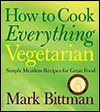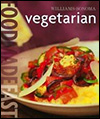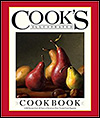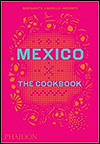 How to Cook Everything Vegetarian
How to Cook Everything Vegetarian
Mark Bittman, 2007
The subtitle is “Simple Meatless Recipes for Great Food”, and the “Simple” is no lie — I was surprised to bring this book home and discover that it was basically a matter of “throw these things in a pot, done”. But the “Great” is less accurate. There’s no alchemy here, which is the main thing I’m looking for in a recipe: combinations of flavors that magically taste like much more than the sum of their parts. These recipes are precisely the sum of their parts. Black‐eyed peas and tofu taste like black‐eyed peas and tofu. Lentils and carrots taste like lentils and carrots. The breaking point was when I compared the ranch dressing recipe in this book to one I randomly happened across online, and the online version was far, far superior.
 Food Made Fast Vegetarian
Food Made Fast Vegetarian
Dana Jacobi, 2007
I liked this cookbook more than the one above on the basis of two recipes that I will be making again: the Mediterranean potato salad was a winner, and the Spanish bean stew did have that alchemy I was just talking about—it was awful when it was half done, and awful when it was 90% done, and awful when it was 99% done, but somehow the moment it clicked over to 100% done it was suddenly delicious. But the pastas were either obvious or meh, the sweet potato curry was another coconut milk bomb like the curries in the Bittman book, and other recipes (corn cakes, potato gruyere tarts) failed even though I followed the instructions precisely. I’ve had enough success with other cookbooks that I can tell when a recipe is beyond me, and these weren’t—they were just bad.
 Mastering the Art of French Cooking
Mastering the Art of French Cooking
Julia Child, 1961, 2001
A lot of these recipes probably were beyond me—many of them relied on techniques that I couldn’t pick up solely from a text. Like, when a recipe says to beat egg yolks until they “form the ribbon”… yes, it does explain what that means, but how are you supposed to know whether what you have qualifies as an adequate rendition of “the ribbon” without a human there to give you a yea or nay? So, yeah, when my profiterole filling turned out to be a disaster, I’m going to say that’s on me. But other recipes I did get right and they just weren’t to my taste: the leek quiche was too oily, the orange cake too rubbery, and the choux pastry gnocchi, while interesting, were not an improvement over the gnocchi that my tried and true Jack Bishop cookbooks taught me how to make. I will say that the green beans in tarragon cream were delicious, but it seems like a lot of what little success I did encounter in making these recipes did just come down to the fact that drowning things in cream will usually make them pretty tasty.
 Cook’s Illustrated Cookbook
Cook’s Illustrated Cookbook
America’s Test Kitchen, 2011
So the basic idea behind Cook’s Illustrated is that the creators take a scientific approach to cooking, dispensing with conventional wisdom and comparing and contrasting different approaches to a dish until settling on the very best rendition. The problem with this approach? Tastes differ, and I generally find that what Cook’s Illustrated values in a recipe, I find gross. “Most brownies are too cakey! Here is a recipe that guarantees the perfect fudginess you want!” Well, no—I like cakey brownies, and these fudgy ones were dense and a chore to eat. “Most cookies are too flat! Here is a recipe that guarantees the perfect height you want!” Well, no—I actually don’t like cookies that look like hockey pucks. A lot of recipes rely on One Weird Trick and it’s usually a mistake. “Don’t use ricotta in your baked ziti: use cottage cheese!” No, this was awful. “Don’t make polenta out of actual polenta: use corn grits and mix in some baking soda!” This was about five percent as good as my regular polenta. Time after time, the Cook’s Illustrated recipes turned out dishes that were triumphantly inferior. A lot of this might be expected: of course a catch‐all book like this will turn out Indian food that’s worse than the food in an actual Indian cookbook, and pasta that’s worse than that in an actual Italian cookbook, and so forth. But this book even managed to ruin things like mashed potatoes and leek and potato soup. I will say that the pie crust turned out better than most pie crust recipes I’ve tried. And, as with the Julia Child cookbook, I liked the green beans in cream. But how could green beans in cream ever be bad?
 Mexico the Cookbook
Mexico the Cookbook
Margarita Carrillo Arronte, 2011
This cookbook managed to make green beans in cream taste bad. Oof. I love Italian food and Indian food, and thanks to my good Italian and Indian cookbooks, I can make really good renditions of it at home—Italian food in particular is something I very rarely get at restaurants, because unless they’re really top‐notch (or I’m feeling very lazy) I know I can make much better Italian food by putting in half an hour in the kitchen. But I also love Mexican food, and I’ve had much less success on that front—even a barely above average Mexican restaurant will make my attempts look pretty sad. Sadly, this cookbook didn’t help. A lot of the recipes were a matter of boiling stuff in a pot and then pureeing it until smooth—sometimes the result was called a soup (bleah, smooth soups are boring) and sometimes it was called a sauce, but none of these concoctions were particularly memorable. Disappointing! All I wanted was to be able to make an ancho sauce like at Picante or a pipian mole like at Los Moles, but every recipe in here fell short of those seemingly very attainable goals. And the recipe editing is quite poor. I’d start in on a recipe and the very first line would be “Reduce heat”—huh? Reduce it from what? We’re just getting started! Or I’d assemble all my ingredients and then wonder, uh, what am I supposed to do with this habañero? It’s never mentioned in the instructions! El sigh.



